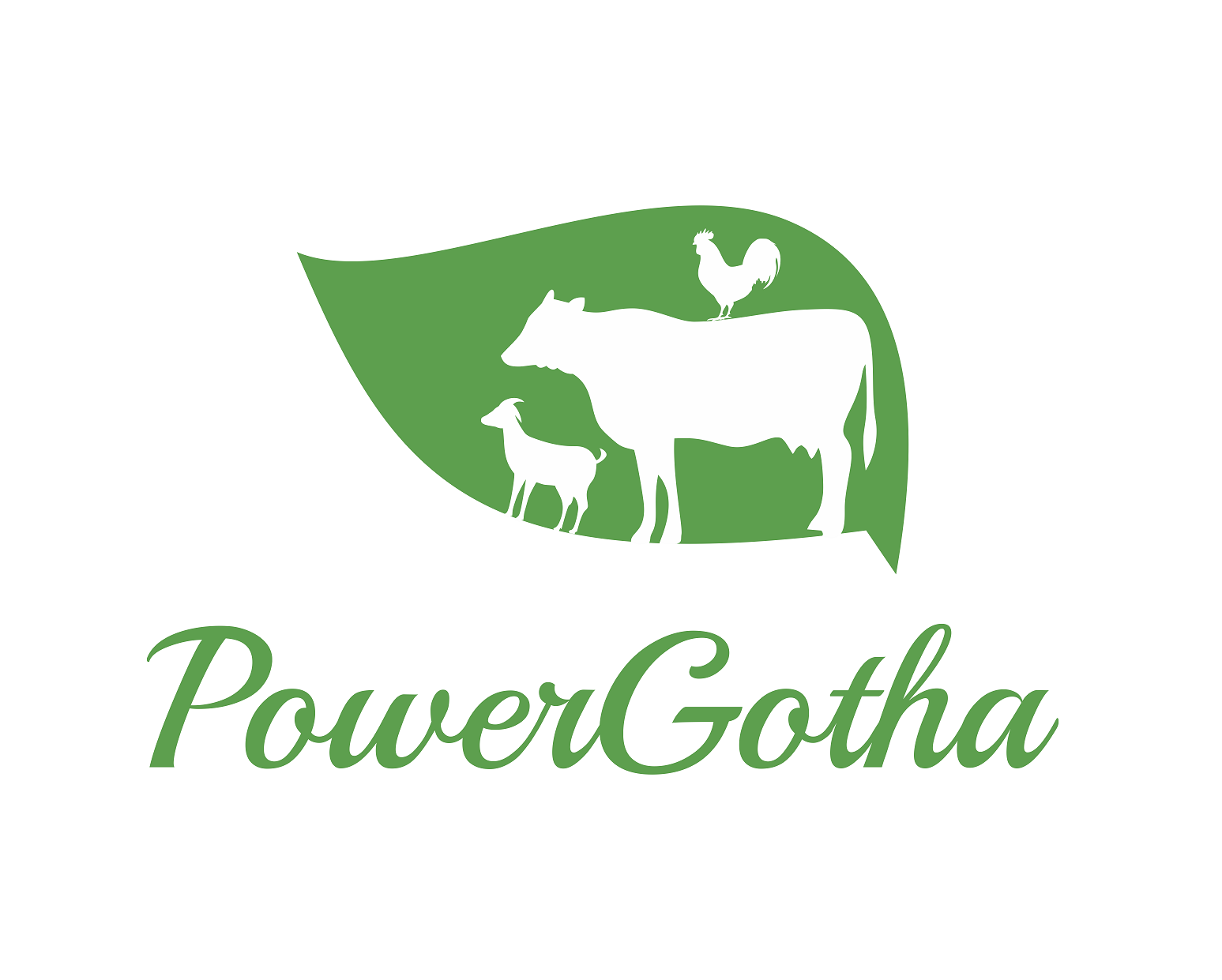Record Keeping in Dairy Farming: Introduction, Benefits, and Types
Record keeping in Dairy Farming is extremely important for a successful and profitable business.
Without proper record keeping, the dairy farmers have to rely on their memory for making crucial decisions.
Record keeping in dairy farming relates to maintaining a record of everything from livestock, calving, growth, vaccination, product yield, feeding, etc.
Maintenance of records not only provides easy access to the important information as and when required but also helps in measuring the progress of the business.
Let us understand the types of records that should be maintained, how they should be maintained and what the benefits of maintaining these records are.
Types of Records You Need to Keep in Dairy Farming
When it comes to the type of content that should be recorded, there are two types: key events and high-value data.
Key events in relation to Dairy Farming are those which require change in daily tasks and processes with regard to individual cows and buffaloes or with regard to complete Dairy Farm. Events such as breeding event – calving, drying off, heat, or de-worming, vaccination are needed to recorded in detail for a successful Dairy Farming Business.
High-value data is recorded from which Dairy Farmer can make sense of the business’s present state and its ability to achieve the target revenue, production or profitability.
This dairy farming records can be used to make better decisions about animals, feed, medicines, capital investment etc. The records include feed records, expenses, weights of calves, milk production, milk quality.
How to Organize Your Records for dairy farming
Dairy farmers must maintain the records from the moment they start procuring the animals.
The earlier you start, the better it is.
If for some reason you have not kept the records from the beginning, there is no wrong time to start doing it. It’s never too late. Start today. Start right now
Once the dairy farmer has decided to maintain the records, the question arises as to how to do it?
There are many ways to do it.
You can opt for manual notes, spreadsheets, computer, and mobile apps.
Where the old school methods like manual record-keeping or spreadsheets may be cumbersome and have errors, computer and mobile applications are systematic, easy to use and accurate.
Types of Record Keeping in Dairy Farming – Forms, Methods, Tools
As mentioned earlier, to run a successful dairy farming business, the dairy farmer should try to maintain records from the very beginning.
Let us understand various different records that should be maintained:
1. Livestock Records/Identification Records: These contain information about the number of animals that are there on the farm. These records also include the name (if any), identification number, sex, date of birth/procurement date, breed, or any other identification mark an animal may have. Pictures or sketches of the animals, which indicate specific features, may also be kept as additional identification records.
2. Production Records: These include the daily production of the farm. The production records are to be kept daily and scrutinized every week. They should then be compared monthly and yearly. This is important to know the exact situation of the farm financially. Production records help in getting a clear picture of the net input and output of the farm. It also helps in making important decisions like if the cost of feeding a particular animal is more than the yield, it might be time to sell the animal or what is the best time to breed a cattle or which combination of cow and bull has most productive off-springs. These records are very useful for making a precise management decision.
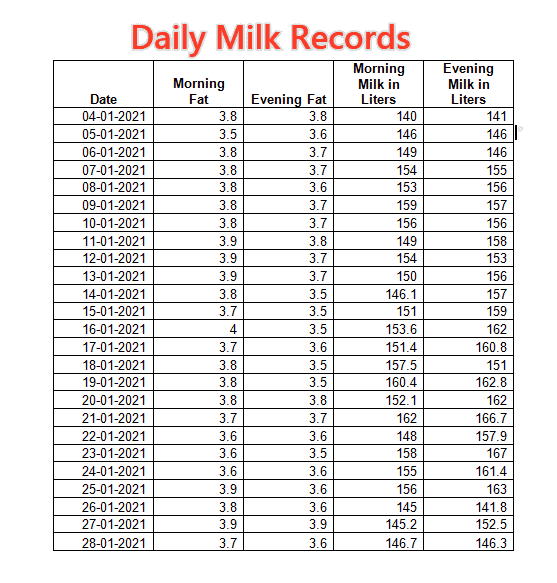
Daily Milk Records
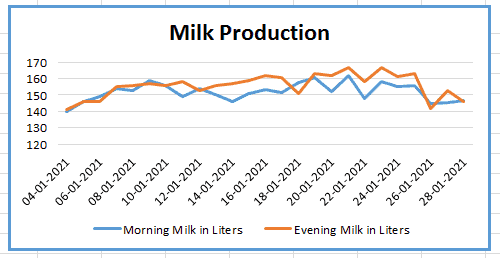
daily Milk Production graph
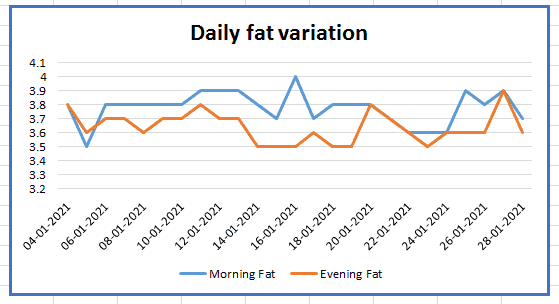
daily Milk quality graph
3. Calving Records: These records include the date of birth, sex, parent history, identification mark, identification number, abnormalities (if any) of all the calves born on the farm.
4. Health Records: Health records are one of the most important records to be maintained by a dairy farmer. These include all the vaccinations, treatment, diseases, and other health-related records of the farm animals. To ensure that the animals are fully vaccinated and well protected against diseases, the health records must be reviewed from time to time. Any outbreak of a disease in the farm can heavily damage the livestock and productivity of the farm.
5. Animal Feed Records: When we talk about animal feed records, we may be talking about the inventory of the types of animal feed procured or the quantity or quality of animal feed procured, or even the amount/type of feed given to a particular animal on the farm. All these records are to be kept and maintained individually. The total procurement records help in the financial planning of the farm whereas the amount/type of feed records help in keeping a track of the yield of the animal. Feeding plans help in understanding exactly how much feed is required by each animal per day as per their age, breed or gender, etc. For example, the feeding requirements of a pregnant animal are totally different from those of a drying animal.
6. Daily Farm Records: These records are useful in tracking any uncommon activity happening on the farm. Comparing the daily activity records helps the farmer in spotting rare unwanted occurrences. These prove helpful in planning the day-to-day activities and for future events too.
7. Records of Farm Implements and Equipment: It is important to maintain the records of the equipment used on the farm. The record-keeping not only helps in keeping a count of the equipment but also helps in getting timely repairs and servicing if required.
8. Financial Records: The end goal of any dairy farm is to make a profit. The financial records help in keeping the eye on the prize. Financial planning, like any other business, plays an important role in the dairy farming business as well.
Methods:
Now that we have understood the types of records, let us have a look at the methods of record keeping.
1. Manual Record Keeping: Manual record keeping has been there for ages. It may be successful at small farms but as the size of the farm increases, it becomes cumbersome and more prone to errors. Though some methods may be used to make the process a little less tedious such as using a color-coding system, card files, case folders, individual records, tags, etc. This gives a more systematic approach to the records and hence makes them easily accessible for day-to-day field use. A simple example of ‘Reproduction and Lactation History’ is given below:

How to keep records for Dairy Farming in a notebook
2. MsExcel or Google spreadsheet: With the advent of new technologies, record keeping has become simpler and error-free. Computerized record-keeping is more efficient as compared to manual record-keeping and recommended for a farm that is bigger in size.
Screenshot of a useful excel sheet we created for our Power Users is given below
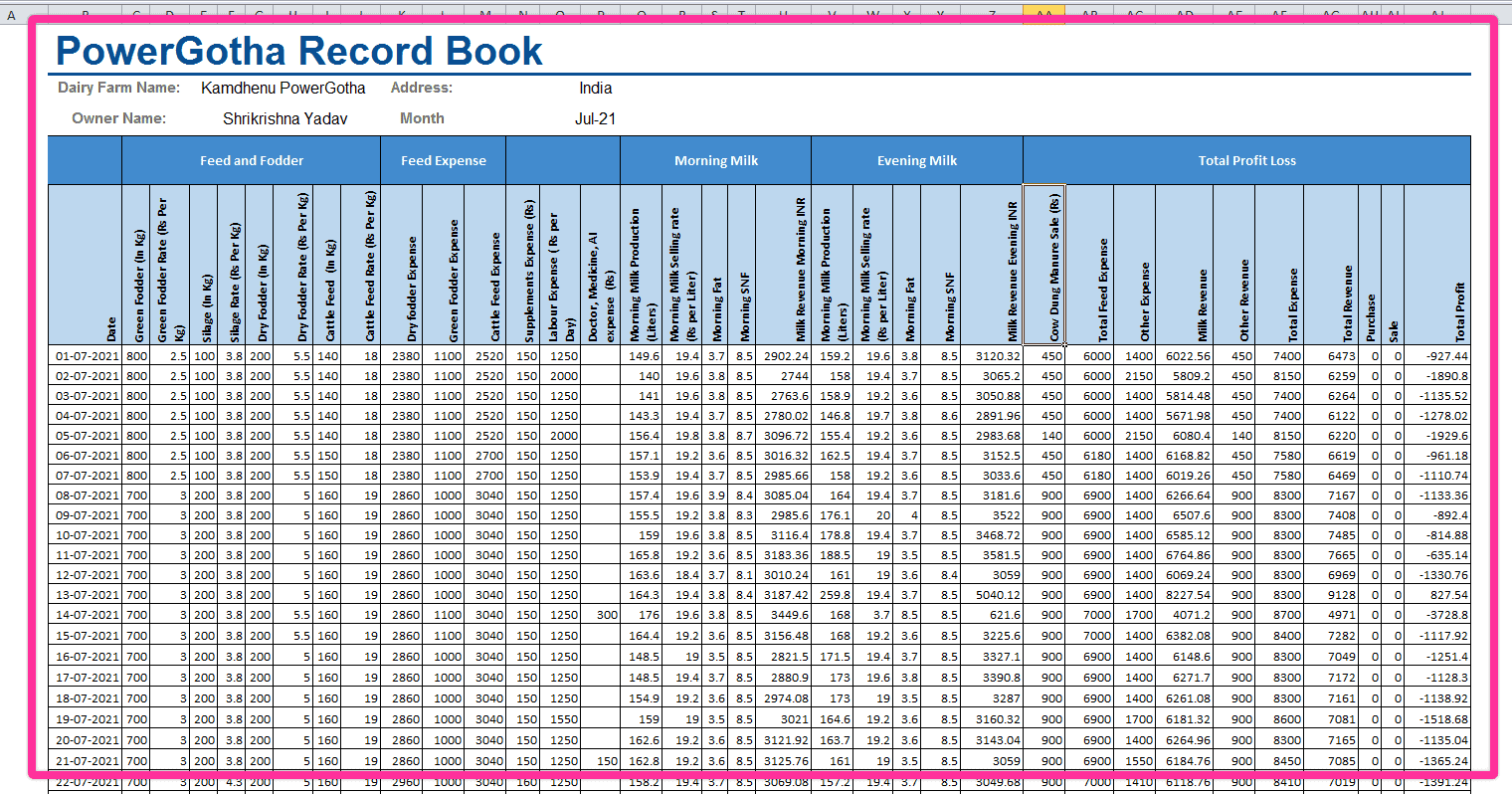
Dairy farm records in Excel sheet or spreadsheet
3. Mobile Apps: The fastest and the easiest way to save records nowadays is through mobile apps. They are easily accessible and just a tap away. They are user-friendly and can be used even by those who are not very computer savvy. ‘PowerGotha‘ is one such app that can be used by both android and iOS users. Basically, it is an app that supports traditional dairy farmers to go modern and helps them use technology to maximize their growth potential. The users may visit the website i.e. powergotha.com or follow the step-by-step instructions given below to download the app.
‘PowerGotha’ provides a variety of record-keeping tools such as Personal Information, Animal Information, Farm Information, Vaccination records, Milk records, Daily records, etc. It is a one-stop app for all your dairy farming needs.
Benefits of Record Keeping:
- It helps in maintaining the size of the farm by identifying the animals which are more productive for the farm and culling the rest.
- It helps in the financial planning of the farm by determining the inflow and outflow of the products. This aids in determining the net profit of the farm and planning ahead.
- It helps in cutting down the cost of production.
- Record keeping is an excellent tool for keeping a check on the vaccination schedule, diseases, or any other unusual activity on the farm.
- The record-keeping also assists in pregnancy detection test dates and planning breeding schedules to maintain the output of the farm.
- Feeding records help in maintaining healthy meals for the animals and thus increasing the overall yield.
- It also enables a farmer to determine the price of the products.
- Procurement and selling of animals become easy when you have access to the entire records of the animal.
- In case of inbreeding, it helps in testing which progeny is more desirable.
- Maintained records are also beneficial if the dairy farmer wants to get a loan from the bank to expand the business.
- Record keeping is also effective in the overall management of the farm.
If for some reason you have not kept the records from the beginning, there is no wrong time to start doing it. It’s never too late. Start today. Start right now
